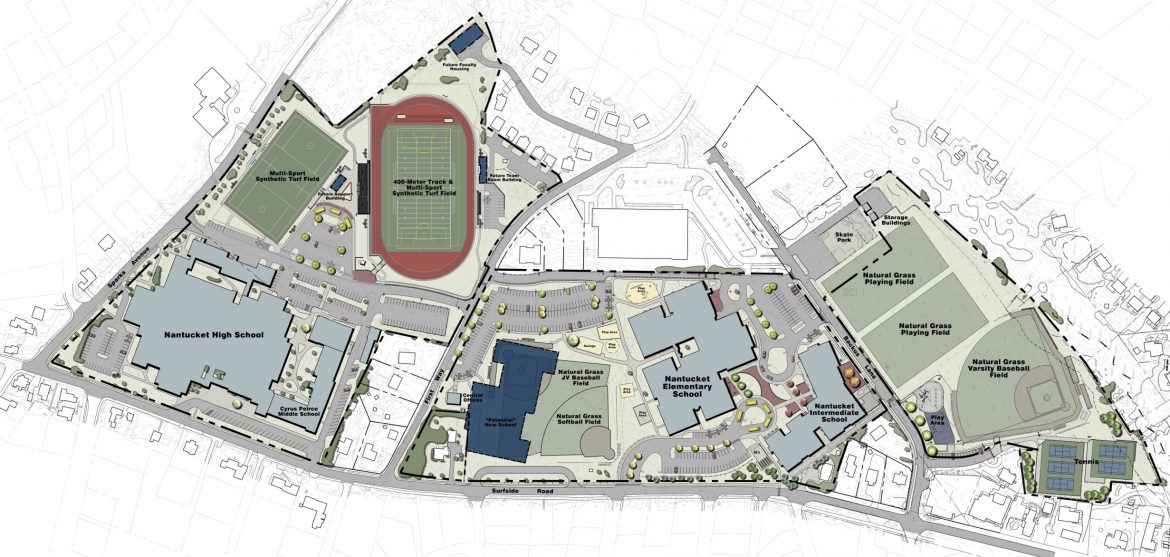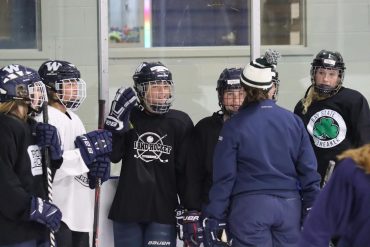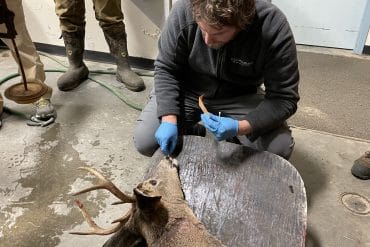The controversial plan to install two artificial turf fields as part of the Nantucket Public Schools’ larger campus-wide facilities improvement project is on hold. For now, at least.
In an email obtained by Nantucket Current, SMRT landscape architect John McMeeking stated the school’s Campus Wide Master Plan Committee had made the “difficult decision” to put all the proposed upgrades for the area behind Nantucket High School and Cyrus Peirce Middle School on hold. That area includes the two proposed turf fields. McMeeking and SMRT are the team hired by the school to design the facilities upgrade project.
The other portions of the project – namely the natural grass baseball field and tennis courts off Backus Lane – will still be pursued as designed.
The $17.5 million project, which has been in the works for years, had in recent months become mired in the debate over PFAS, the so-called forever chemicals that are suspected to increase the risk of kidney and testicular cancers, as well as other health conditions, and are used during the manufacturing process for turf fields.
“Unfortunately, it appears that support for the portion of the project behind the high/middle school from Town leadership is not where it needs to be in order for a successful outcome at Town Meeting and Election,” McMeeking wrote to the members of the committee.
McMeeking alluded to the concerns regarding PFAS and how to respond to them as the committee regroups: “Also, it was agreed that the committee needs to strategize on the best approach to further investigate the concerns some members of the community have voiced, research and compile recent and relevant data in response to those concerns and present those findings to further update the community on the overall benefits of the master plan (including the need for synthetic turf fields).”
The Nantucket School Committee is scheduled to discuss the project again Tuesday evening at 6 p.m.
Dave Fredericks, a member of the Campus Wide Master Plan Committee, said Monday that decision to put the turf fields on hold, while difficult, was the right one considering the tenor of the debate over the project that has unfolded on the island in recent months.
“It’s an honest attempt to take a deep breath and say ‘this shouldn’t be so strained’,” Fredericks said. “It was clear to everyone we need to do some more homework and communicate and understand what are the real facts? The committee sees there’s concern and the community has some things they want to better understand. We generally think we should take this time to go forward with a phase of the project that has support, and work with the community to understand all of the concerns and see if they can be addressed and go from there.”
While the Finance Committee recently voted unanimously to endorse the spending for the project, other vocal critics – including Nantucket firefighters who have been outspoken about their own concerns with PFAS in their turnout gear – have repeatedly challenged the project team regarding the potential for PFAS to leach from the turf fields into the island’s groundwater and aquifer.
Nantucket School Committee chair Tim Lepore was among those who questioned the potential risks posed to the island’s aquifer with the installation of synthetic turf fields containing PFAS. His daughter, Nantucket Board of Health member Meredith Lepore, was also outspoken with her concerns regarding the turf fields.
The Nantucket Land Council, the island’s environmental watchdog group, recently came out in opposition to the installation of the turf fields.
“We do not believe this level of unknown risk, given how much we have been learning about the negative health implications of measurable PFAS compounds, is appropriate in Nantucket’s wellhead protection district,” Land Council executive director Emily Molden said.
During a recent School Committee workshop on the project, toxicologist Marie Rudiman and hydrogeologist Steve Larosa, of Weston & Sampson, the firm that was hired by the school to evaluate the risks of PFAS in turf fields, spoke out about those potential risks. Rudiman and Larosa emphasized that testing showed the existing soil on the current athletic fields already have “background concentrations” of PFAS due to ubiquitous nature of the chemicals in the environment. The proposed turf fields, they said, would have similar or lesser concentrations of the chemicals. But even those soil tests have come under scrutiny, with some critics, including former Nantucket Select Board candidate Meghan Perry, claiming that the PFAS testing did not follow proper protocols.
The PFAS experts who were participating in last month’s workshop repeatedly took exception to the comments made by Larosa and Rudiman, and emphasized the lack of long-term studies on the impacts of PFAS, as well as the changing regulatory environment that could soon become far more strict on what is considered a “safe” level of PFAS in drinking water.
Currently, the federal standard for drinking water is 70 parts per trillion (PPT), while Massachusetts has set its standard at 20 ppt, one of the most conservative in the country.
“We have seen some data that shows when artificial turf fields are put in, the surrounding wetlands and groundwater does increase in PFAS levels,” said Dr. Kyla Bennett, the director of science policy at New England Public Employees for Environmental Responsibility (PEER) and a former EPA employee. “My town didn’t have a PFAS problem until we put in turf fields. To say it’s not going to contaminate the groundwater or aquifer is not true.”






